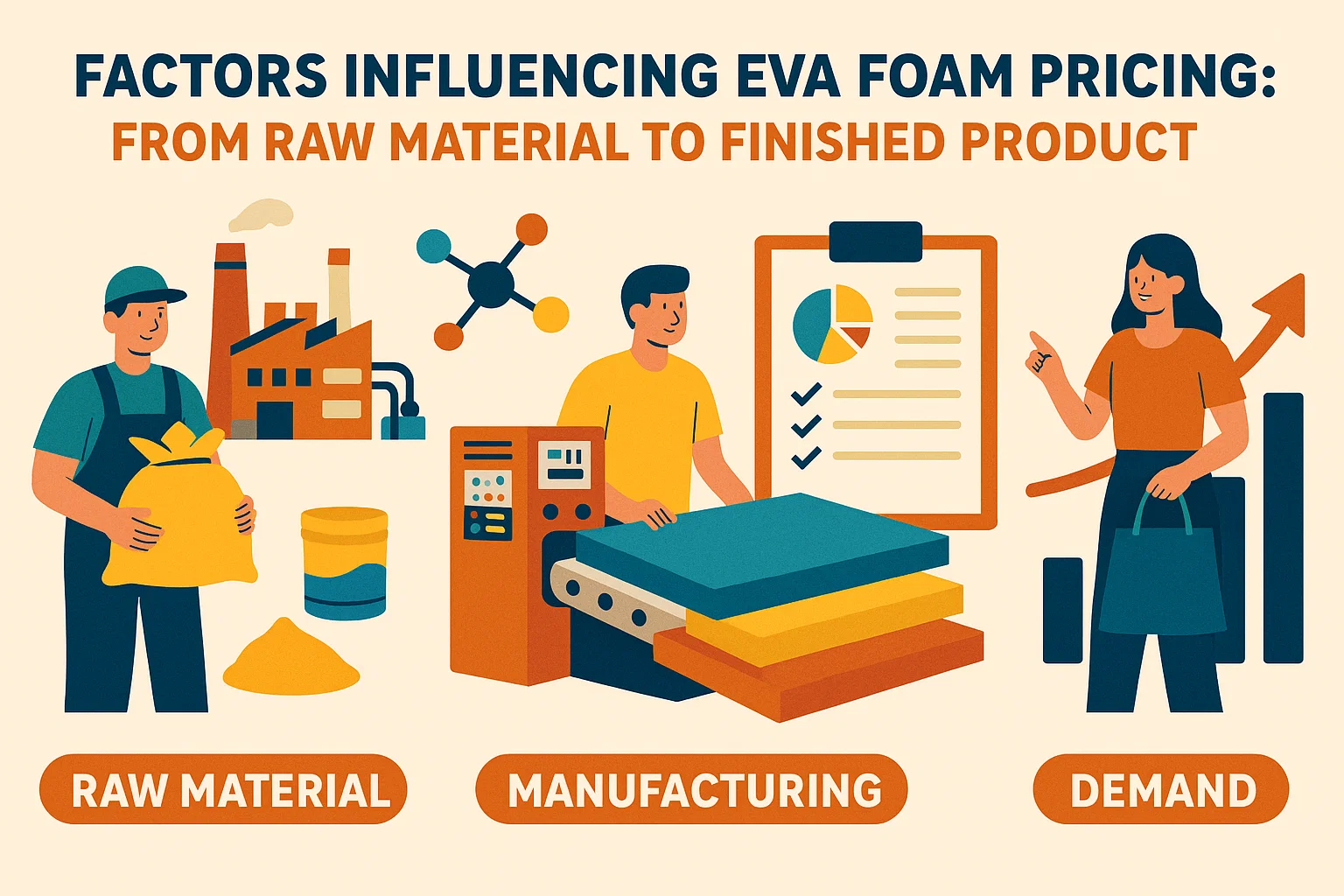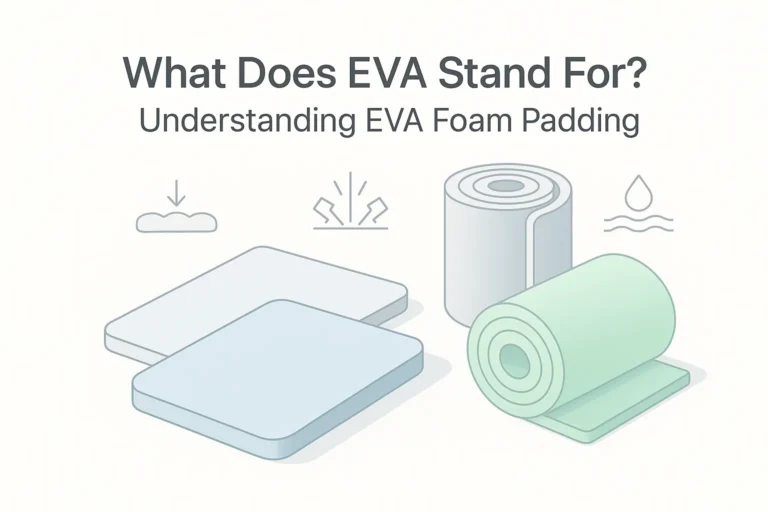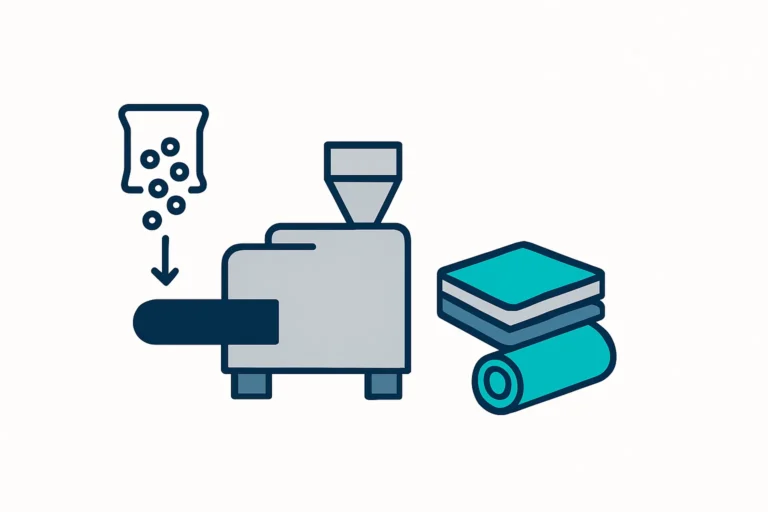Capire i prezzi della schiuma EVA: Una ripartizione completa dalla materia prima al pezzo personalizzato
Disimballare il prezzo della schiuma EVA: Un viaggio dalla materia prima al prodotto finale
Vi siete mai chiesti perché due pezzi apparentemente simili di schiuma EVA possono avere prezzi molto diversi? La risposta si trova in un affascinante percorso di chimica, produzione e personalizzazione. Cerchiamo di scoprire cosa determina veramente il costo.
🧪1. Il fondamento: Le materie prime
Il viaggio inizia con gli ingredienti principali: Etilene e Acetato di Vinile (VA). Il prezzo di questi prodotti petrolchimici fluttua con il mercato petrolifero globale. Ma soprattutto, il contenuto di VA determina le proprietà della schiuma. Un contenuto più elevato di VA significa generalmente una maggiore morbidezza, flessibilità e chiarezza, ma ha anche un costo elevato. La purezza del materiale è un altro fattore chiave: i polimeri vergini di alta qualità costano di più rispetto alle alternative riciclate o di qualità inferiore.
⚙️2. La ricetta: Formulazione e schiuma
È qui che avviene la magia. Non utilizziamo semplicemente polimeri grezzi, ma creiamo una ricetta precisa. I principali fattori di costo in questa fase includono:
- Densità e durezza: Le schiume più dense e di maggiore durezza richiedono una maggiore quantità di materie prime e un processo più controllato, con un conseguente aumento dei costi.
- Colore: L'abbinamento personalizzato dei colori richiede pigmenti specifici e test, con un conseguente aumento del prezzo rispetto al nero o al bianco standard.
- Additivi: Avete bisogno di proprietà ignifughe, antistatiche o resistenti ai raggi UV? Questi additivi specializzati rappresentano una componente significativa dei costi.
📏3. La forma: Produzione e conversione
Una volta schiumato, il blocco grezzo deve essere convertito in un formato utilizzabile. Ogni fase aggiunge valore e costi. In qualità di fornitore leader di prodotti versatili Schiuma EVA, lo elaboriamo in:
- Fogli: Affettare o "tagliare" il blocco in spessori precisi. Le lastre più sottili possono richiedere un trattamento e una lavorazione più accurati.
- Rotoli: Per le applicazioni continue, i blocchi vengono laminati e laminati, un processo che richiede macchinari specializzati.
✂️4. La finitura: Realizzazione su misura
È qui che una semplice lastra si trasforma nella vostra soluzione specifica. La complessità della lavorazione è un fattore determinante per la determinazione del prezzo. I servizi includono:
- Fustellatura: Conveniente per volumi elevati e forme semplici.
- Lavorazione CNC: Ideale per progetti e prototipi complessi e a più livelli, offre un'incredibile precisione.
- Termoformatura: Stampaggio della schiuma in forme 3D per applicazioni come inserti di valigie o imbottiture.
- Laminazione e adesivi: Applicazione di supporti adesivi sensibili alla pressione (PSA) o laminazione di materiali diversi.
Domande frequenti
Perché esiste una gamma di prezzi così ampia per la schiuma EVA?
La gamma di prezzi riflette le grandi differenze nella qualità delle materie prime, nella densità, negli additivi speciali (come i ritardanti di fiamma) e nel livello di lavorazione personalizzata. Una semplice lastra di densità standard sarà sempre più conveniente di un pezzo personalizzato, colorato e lavorato a CNC con un supporto adesivo.
La schiuma EVA più densa o più dura è sempre più costosa?
In generale, sì. Le schiume a densità più elevata utilizzano più materie prime per volume cubo. Inoltre, spesso richiede un processo di produzione più intensivo per raggiungere determinati gradi di durezza (Shore), il che contribuisce ad aumentare i costi.
Come posso ottenere la soluzione più conveniente per il mio progetto?
Il segreto è trovare un equilibrio tra prestazioni e prezzo. Siate chiari sui vostri requisiti "indispensabili" rispetto alle caratteristiche "piacevoli da avere". Ordinare volumi più elevati può anche ridurre significativamente il costo unitario grazie alle economie di scala nella produzione e nella configurazione.
Capire i costi. Perfezionare il progetto.
Ora che sapete cosa comporta il prezzo della schiuma EVA, cerchiamo di trovare la soluzione perfetta e più conveniente per le vostre esigenze. Che si tratti di lastre, rotoli o di un pezzo completamente personalizzato, il nostro team è a disposizione per fornire un preventivo trasparente e non vincolante.
Richiedete oggi stesso il vostro preventivo





